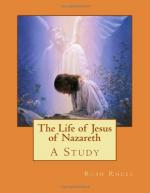259. The latter of these titles is unique in the use Jesus made of it. Excepting Stephen’s speech (Acts vii. 56), it is found in the New Testament only in the sayings of Jesus, and its precise significance is still a subject of learned debate. The expression is found in the Old Testament as a poetical equivalent for Man, usually with emphasis on human frailty (Ps. viii. 4; Num. xxiii. 19; Isa. li. 12), though sometimes it signifies special dignity (Ps. lxxx. 17). Ezekiel was regularly addressed in his visions as Son of Man (Ezek. ii. 1 and often; see also Dan. viii. 17), probably in contrast with the divine majesty.
260. In one of Daniel’s visions (vii. 1-14) the world-kingdoms which had oppressed God’s people and were to be destroyed were symbolized by beasts that came up out of the sea,—a winged lion, a bear, a four-headed winged leopard, and a terrible ten-horned beast; in contrast with these the kingdom of the saints of the Most High was represented by “one like unto a son of man,” who came with the clouds of heaven (vii. 13, 14). Here the language is obviously poetic, and is used to suggest the unapproachable superiority of the kingdom of heaven to the kingdoms of the world. The expression “one like unto a son of man” is equivalent, therefore, to “one resembling mankind.” The vision in Daniel had great influence over the author of the so-called Similitudes of Enoch (Book of Enoch, chapters xxxvii. to lxxi.). He, however, personified the “one like unto a son of man,” and gave the title “the Son of Man” to the heavenly man who will come at the end of all things, seated on God’s throne, to judge the world. This author used also the titles “the Elect One” and “the Righteous One” (or “the Holy One of God"), but “the Son of Man” is the prevalent name for the Messiah in these Similitudes.
261. The facts thus stated do not account for Jesus’ use of the expression. Many of his sayings undoubtedly suggest a development of the Daniel vision resembling that in the Similitudes. This does not prove that Jesus or his disciples had read these writings, though it does suggest the possibility that they knew them. It is probable, however, that the apocalypses gave formulated expression to thoughts that were more widely current than those writings ever came to be. The likeness between the language of Jesus and that found in the Similitudes may therefore prove no more than that the Daniel vision was more or less commonly interpreted of a personal Messiah in Jesus’ day.
262. Much of the use of the title by Jesus, however, is completely foreign to the ideas suggested by Enoch and Daniel. Besides apocalyptic sayings like those in Enoch (Mark viii. 38 and often), the name occurs in predictions of his sufferings and death (Mark viii. 31 and often), and in claims to extraordinary if not essentially divine authority (Mark ii. 10, 28 and parallels); it is also used sometimes simply as an emphatic “I” (Matt. xi. 19 and often). Whatever relation Jesus bore to the Enoch writings, therefore, the name “the Son of Man” as he used it was his own creation.




